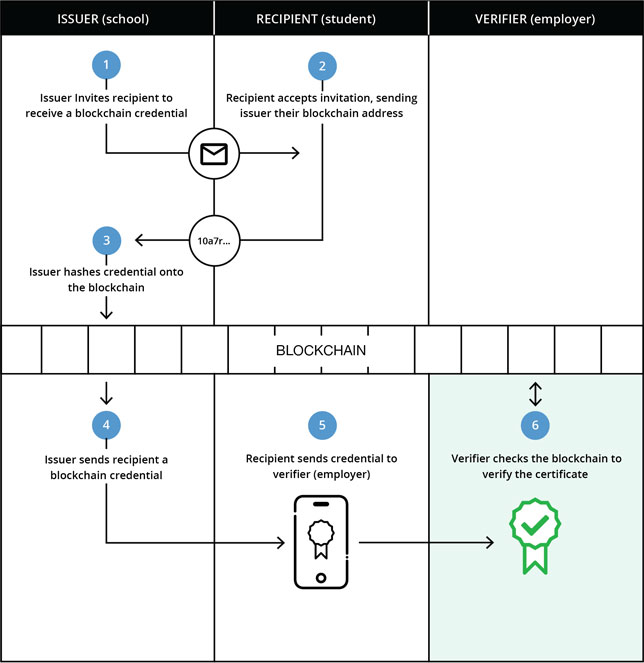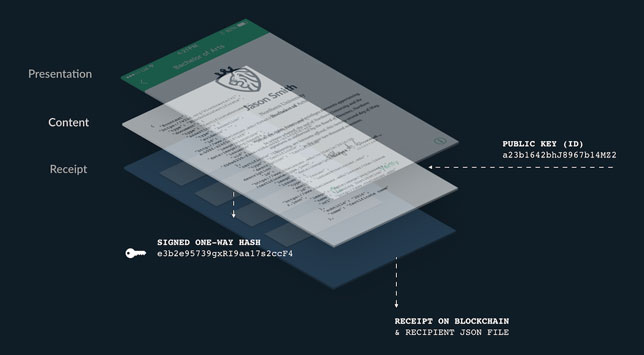Going Beyond the Digital Diploma
Managing digital transcripts is the top use case for blockchain in the higher education space, but more colleges and universities are starting to explore the technology's potential in new ways.
In 2017, the Massachusetts Institute of Technology and Central New Mexico Community College became the first institutions in the United States to experiment with offering students the option to receive a digital diploma through a blockchain-based app. Once students graduate, they can use their phones to download a copy of their diplomas as a JSON file, and that file can be shared with employers who confirm the information through a degree verification portal.
"From a trust and immediacy of information standpoint, we saw the real potential of putting trusted and effective records out into the world," said Mary Callahan, senior associate dean and registrar at MIT. "Fraud was one of my motivations because we wanted to make sure that we could have something that is tamperproof, has data-rich verification and is readable by humans and machines."

How blockchain credentials work
Both institutions use the Blockcerts open standard that was developed at the MIT Media Lab and by Learning Machine as an alternative to the burdensome process used by most colleges and universities through the National Student Clearinghouse. With Blockcerts, the process for verifying a diploma is simplified into two steps rather than waiting on the Clearinghouse to certify the credentials.
Now, other institutions like Southern New Hampshire University and East Coast Polytechnic Institute University are following the lead of MIT and CNM and using Blockcerts to explore how digital diplomas can be used to make the verification process easier for their students.
"We see great opportunities with this platform to create a more streamlined approach to help with students transferring, receiving degrees, honoring requests to verify degrees and to admit new students and evaluate their transcripts," said ECPI University CIO Jeff Arthur. "The ability to let someone hold all of their accomplishments on their phone and have them to share with anybody in a way that is secure and reliable — without having to chase down entities to verify — is attractive to us."
Transcripts Reimagined
The ability to offer and share transcripts via the Blockcerts app is close to fruition, according to Natalie Smolenski, senior vice president of business development at Learning Machine. "Learning Machine's product has evolved to accommodate additional use cases including transcripts, which we are launching this summer," she noted. "We are going to offer the capability to display much more granular, structured data, which you would need for detailed academic records."

Anatomy of a Blockcert
College and university CIOs also hope that blockchain technology can help to streamline other administrative functions. For instance, the ability to transfer credits between institutions could be simplified, according to Arthur.
The current process at ECPI University involves a digital credentialing service called Parchment that helps to match courses completed at one institution with ones offered at a corresponding institution. However, a faculty member is still needed to view the transcript and manually enter the information for each course completed.
Arthur's goal is to eventually give students the capability to upload their transcripts onto an ECPI University portal and get an immediate degree audit against everything that the school has to offer. The audit would provide students with information on degree requirements and how long it would take to complete a degree at ECPI University.

The Blockcerts wallet
"If we get to this point, it would change the whole dynamic of how students are able to explore all of their best transfer options and it would lower the cost for students to understand what is the fastest path to earning a degree at certain institutions," said Arthur. "Right now, it could take a month or two to get the document where you need it to go and then complete the evaluation process, because someone needs to read the transcript."
Micro-Credentialing
The next big leap for blockchain in the higher education space is likely to be the ability to put badges and certificates for technical skills on the chain. At CNM, the college has been working on an effort to create a micro-credentialing solution with IBM, the University of New Mexico and Presbyterian Hospital Services.
"While we are talking with IBM to build this solution, we have decided to build a consortium for the blockchain educational platform because the toolkits that we are using could easily be used by other educational institutions," said CNM CIO Feng Hou. "We would like to offer the toolkits to other educational institutions so they don't have to build from scratch."
Micro-credentialing would allow CNM to give students badges for completing a semester-long course that teaches a specific skill. CNM is part of a consortium created by the Education Design Lab to determine the content and format for the open badge standard, and IBM is working on the infrastructure for the platform where students, faculty and employers will be able to view the data.
Once the platform goes live, Hou said he wants to drill down further into the weeds to allow employers to search through student profiles for certain skill sets, and also let college administrators know what skills are most in demand.
"Since we are partnering with IBM and utilizing Watson's capabilities, we will be able to build a smart pathway for our students," said Hou. "For instance, if you take a digital badging program, then you can figure out the next steps to take to lead you to a career, profession or degree program using the platform."
The Disruptor
While colleges and universities in the U.S. are just starting to explore how blockchain could revolutionize credentialing, academics are looking into how to upend the traditional model of attending college. Professors from the University of Oxford (England) and University of Cambridge (England) are working together to create a borderless university called Woolf University (online), where blockchain technology takes on the role of traditional administrators.
"Woolf will provide a vital platform through which students from all over the world can study and learn. Further, by structuring courses around tutorials, students will gain incredible one-to-one access with experts in their fields. In this way online education becomes personal, academically rigorous and bespoke," said Helen Ackers, a teaching fellow at the University of Warwick (England), in a Medium blog post.
The educational platform is designed to lower tuition fees while increasing faculty pay by using blockchain-based smart contracts to automate administrative tasks and reduce administrative overhead costs. The founders of Woolf University are currently seeking accreditation from the European Union and plan to have a global launch later this year.
Blockchain at Scale
For now, the focus in the U.S. is building up a critical mass of schools to explore the digital credentialing use case for blockchain at scale.
"We see more schools wanting to cut down on internal verification costs and to have a system where all of the credentials issued are in one place," said Learning Machine's Smolenski. "This is where we see the value that we can present to market and we expect to see a real uptick in interest in 2019."
MIT's Callahan said she has seen more individual conversations going on at various colleges about badges and credentials, but there hasn't been a wholescale movement to adopt blockchain for micro-credentialing.
"There are financial considerations that need to be taken into account to create the model of how this will work in practice," said Callahan. "Registrars are very interested in the value for the students of digital credentials, but it becomes an issue for the university itself on how to fund this activity."
To expand the possibilities of what blockchain can do, Callahan said MIT is currently working on an awareness program to build up the number of students accessing the mobile app and sharing their diplomas with employers.
"We want to create a lifelong learning approach where people who want to represent their skills and experience can do so through a blockchain-based app," said Callahan. "I consider this initiative as a way to help students gain a foothold in the world, which will require us to be more facile and nimbler to create a suitable experience for students."
About the Author
 Sara Friedman is a reporter/producer for Campus Technology, THE Journal and STEAM Universe covering education policy and a wide range of other public-sector IT topics.
Sara Friedman is a reporter/producer for Campus Technology, THE Journal and STEAM Universe covering education policy and a wide range of other public-sector IT topics.
Friedman is a graduate of Ithaca College, where she studied journalism, politics and international communications.
Friedman can be contacted at [email protected] or follow her on Twitter @SaraEFriedman.
Click here for previous articles by Friedman.